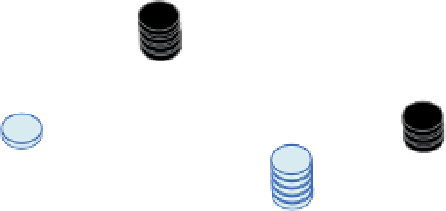Game Development Reference
In-Depth Information
n
The next player rolls the die and does the same thing, placing ore or ice tokens
somewhere on the table. Players keep placing tokens until both piles are depleted
and all the tokens are on the table (if the die roll is higher than the number remain-
ing, simply put all the remaining tokens of that color into play).
Figure 9.8
displays what a two player setup might look like. Note that it is permis-
sible to place lodes adjacent to each other.
FIGURe 9.8
ice and ore lodes
spread across the
“surface of the moon”
Once all the ice and ore tokens are placed on the table, the first player sets up his
starting colony with three tokens of his color. These tokens represent stations. He
must place one token so that it touches exactly one ice lode and one token so that
it touches exactly one ore lode. This claims those lodes for him, and no other player
may set up a station touching his lode. He may place the third token anywhere
he likes, including to claim another lode. If it does not touch a lode, it is called a
way station
(see the next section, “Stations”) and is used to help transport ice and
ore. Initially, these materials cannot be transported farther than the length of the
short side of the playing card, so it is best to keep the stations relatively close to one
another. Way stations are used to close larger gaps.
When the first player is finished, the next player sets up his colony in the same way,
and so on, until all players have set up their colonies.
Figure 9.9
shows how two
players placed their colonies and are now ready to start playing.
FIGURe 9.9
The game is set up,
and two players (red
and blue) are ready
to play.























